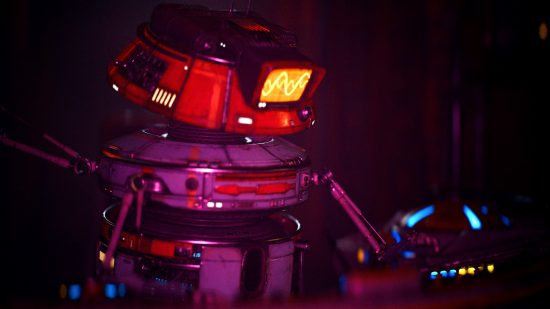As enjoyable as Jedi Fallen Order is, Respawn Entertainment’s Star Wars Jedi Survivor builds on the bones of the first game to deliver a bigger and better experience – one that easily makes it one of the best PS5 Star Wars games out there and certainly one of the best Xbox Star Wars games available. One rather underappreciated aspect of that is Star Wars Jedi Survivor‘s music; particularly the incredible music mix Ashe and DD-EC bring to Koboh’s Pyloon’s Saloon – a hub area where players can talk to some of the most interesting Star Wars Jedi Survivor characters, pick up new gear and cosmetics, and even check on all the fish they’ve found with Skoova Stev – is not-only a wonderful bit of worldbuilding from Respawn, but it’s also something that fosters a distinctly ‘Star Wars’ atmosphere in the cantina.
In the same way that the Bith band Figrin D’an and the Modal Nodes bring so much to the Mos Eisley cantina in A New Hope, Greez’s establishment wouldn’t be half as interesting without the Sounds from the Galactic Skylanes filling the air. But how did Respawn actually manage to pull together an entire album of in-universe cantina music for Jedi Survivor? Well, we asked, and it turns out the Sounds from the Galactic Skylanes album was built on Zoom calls, emails, and quite a bit of creative freedom.
Speaking with The Loadout recently, Jedi Survivor’s music director Nick Laviers reveals that the studio and the bands it was collaborating with “did it all on Zoom” at first, before transitioning into “mainly email communications”. Rather surprisingly, it doesn’t sound like that had much of an impact, and if anything probably opened Respawn up to working with musicians from across the globe.
When asked about his experience throughout the process itself, Laviers expresses that “it was definitely fun” and unique in the sense that the bands he worked with “all had their different ways of working, and different approaches” to the project. We suppose choosing an eclectic mix of artists and musicians, from Mongolian folk metal band The HU to Turkish psychadelic rock band Altın Gün and Florida-based producer Kaelin Ellis made that somewhat inevitable. However, here – and throughout our discussion – Laviers makes it clear that this was always the plan.

Respawn “wanted to go wide” when it came to the artists and musicians it collaborated with while producing this album of in-universe music, with curating a selection of “really interesting [and] really unique characteristic sounds” always at the forefront. However, it sounds like the whole process itself was actually made easier by the fact that Laviers – who was continuously collaborating with composers Stephen Barton and Gordy Haab, whose work Laviers praises throughout our talk – wanted to preserve the uniqueness of each artist as much as possible.
“When we first started talking to the bands, we created this ‘Star Wars style guide’… But, the preface to that was ‘it’s just a guide, and we want you to be you, most importantly’… That was Stephen Barton’s big mantra, that the bands had to be them… he really drove that [home]”.
Laviers admits that he has a “tendency to be a little bit more of a control freak”, but Barton made it absolutely clear that “the bands have to be the bands” – and we agree with Laviers when he says that this was “a really good call”.

Despite the fact that he doesn’t explicitly say that this made the process itself any easier, the way he was discussing it – from the first “kick-off Zoom call with everybody involved” to the “back and forth” emails – made it clear that this was far from a trying situation. He did make it clear, though, that this was something that was “different for everyone” – with “some of the bands [having] nothing to begin with and some of the bands [bringing] a ton of stuff, right off the bat”.
Respawn – Laviers, Barton, and Haab – approached this collaborative process by “letting the bands have as much creative control as possible” – even when it came to picking their artist names and album covers. Of course, there was some “tweaking” involved and Laviers mentions that he “honed in on” certain areas of each band’s music which screamed ‘Star Wars’ when it came to guidance. Overall though, it certainly sounds like each artist had a lot of autonomy – which explains why there are so many wonderfully-different sounds in the album.
Laviers admits that he “would have loved to have worked with the bands in person” during development. However, with these unique sounds coming from bands spread across cities like Rochester, Amsterdam, and Tel Aviv – during a global pandemic, of course – this was certainly the right way to go about things. To us, and to many Star Wars fans as well, quality hasn’t been compromised with this approach either – this is truly a stellar album of in-universe Star Wars music.

We still think Star Wars Jedi Survivor deserves some sort of Horizon Forbidden West-style DLC, and a title screen as brilliant as Red Dead Redemption 2’s main menu, but we do really think it could do with a second volume of Sounds from the Galactic Skylanes. It sadly doesn’t sound like one’s coming, but this eye-opening discussion proves that there’s so much more room in the Star Wars universe for unique music – outside of Max Rebo’s smooth jizz – and we want to hear even more of it.
